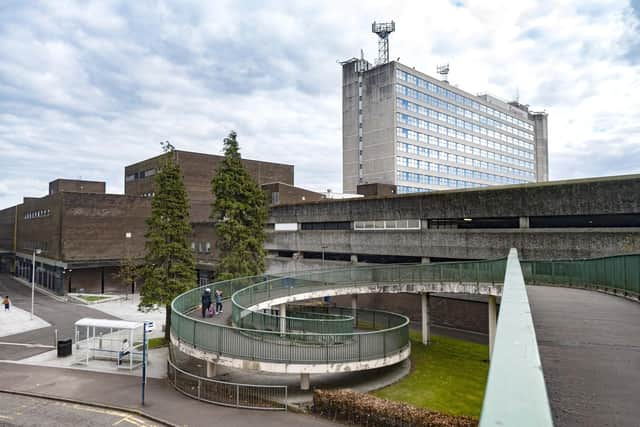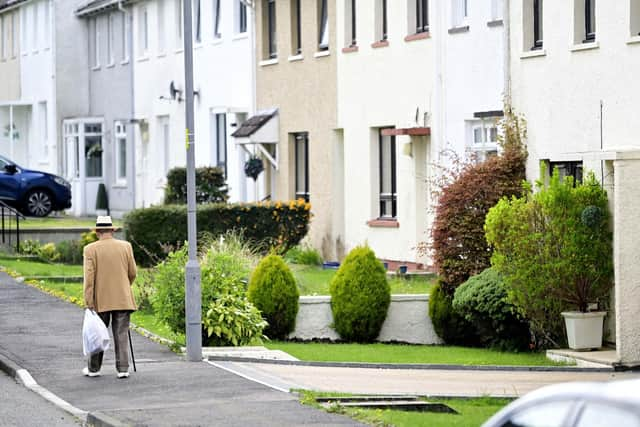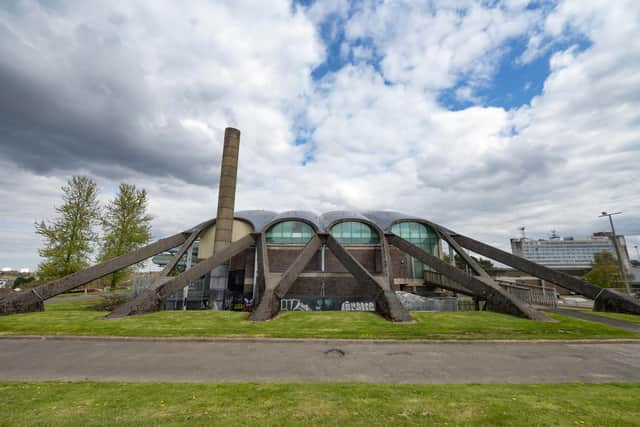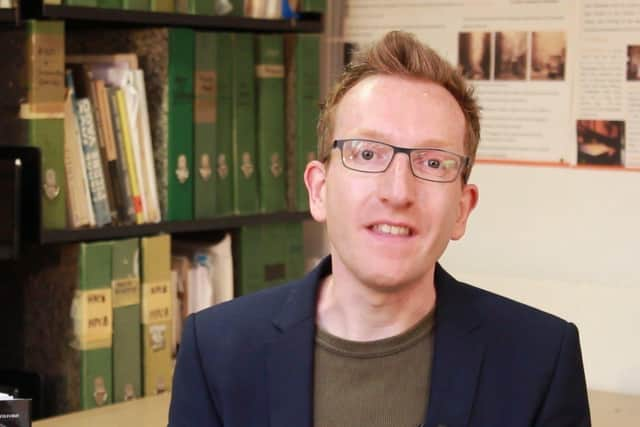East Kilbride: 75 years since planners gazed at open fields and foresaw an urban Utopia – Dani Garavelli
It is 75 years since its official designation; 75 years since planners gazed at the open fields around the original village and foresaw a 40,000-strong urban Utopia, a series of neighbourhoods where those once trapped in the smoggy city’s tired tenements could work and breathe and play.
Their dream was forged in post-war optimism; the values that produced the welfare state, rendered in brick and mortar. East Kilbride would be both prosperous and progressive. Its homes, its factories, its leisure emporia would be beacons of modernism, lighting the way to a better future. Its children would be emblems of upward mobility.
Advertisement
Hide AdAdvertisement
Hide AdThe old 1960s films made to trumpet its growth fizz with idealism. “The East Kilbride Development Corporation was determined the new town would be everything the overcrowded city centres were not,” the RP voice of one narrator intones over images of tree-planting and factory workers handling hi-tech components.


On its diamond jubilee, I want to find out how much of that promise endured. Are its estates still characterful? Are its streets still studded with greenery? Are its buildings still thrillingly futuristic or grim monuments to misplaced hope?
Through the oblong window of the top deck of the Number 18 bus, a 2022 movie unspools. And the town it promotes still has plenty of charm. From Westwood to Calderwood (via Whitehills, St Leonards and the Murray), there is a touching concern for aesthetics and people’s well-being. You can see it in the way colour is used to personalise similar-style houses, and in the old signs, bearing the street name and the name of the estate, which help with orientation. You can see it in the proliferation of schools, parks and mini-town centres, creating self-contained communities so different to peripheral city estates like Castlemilk and Drumchapel.
Visually, what strikes is the geometry - all the interesting lines and shapes: the sharp edges of the stepped terraced houses; the jagged triangles of Moncreiff Parish Church; the stream of cars flowing round the roundabouts, all contrasting with the undulations of the surrounding landscape.
In the mid-2000s, Anne Ward, photographer and author of a series of books revealing the “hidden joys” of particular places, took that same journey most days as she travelled from her home in Burnside to her job at the Department for International Development in the town.


She fell for East Kilbride and went on to capture its romance in a series of images. Later, Frame, who grew up in Westwood, asked her if he could use some of those images as a backdrop to concerts marking the 30th anniversary of his band, Aztec Camera's debut album High Land, Hard Rain. The concerts included a set drawn from his “East Kilbride period”: the songs that would appear on the band's two Postcard singles and form the basis of its unreleased Postcard album, Green Jacket Grey.
“Before I moved to Burnside in 2003, I had never visited because no-one ever gave an impression there was a need. I assumed it was a god-forsaken place,” Ward says. “But, because we were close, we started going to shop and to explore and I thought: ‘This is really nice.'
“Scottish new towns tend to be written off as dystopian, but East Kilbride didn’t seem that way at all. As I travelled to work, I passed rows and rows of terraced houses that were all really neat. And the layout was community-minded. The estates didn’t have the barriers you would see in a new housing estate, where everything is fenced off. In new estates, there’s one way in and one way out, but East Kilbride felt more permeable and relaxed.
Advertisement
Hide AdAdvertisement
Hide Ad“The houses were all quite equal. It didn’t feel like there were good bits and bad bits. And it looked easy to get around. There were underpasses and they had tried to make it bike and buggy-friendly. I don’t live there so I don't know if it works, but you can see what they were trying to do, and it was a noble thing.”


*********************
It was a noble thing. Towards the end of WWII, the government had turned its attention to reconstruction of the UK’s cities: the problem of the urban slums and the peripheral estates which were so lacking in amenities Billy Connolly called them "deserts wi’ windaes".
It decided the best way forward was to decant people out into specially-created urban zones, each with its own distinct and positive identity. The New Towns Act was passed in 1946 and the Town and Country Planning Act the following year.
Though five English new towns were already underway by the time East Kilbride was designated, it was the first in Scotland and part of the initial wave.


"East Kilbride is typical of the New Towns created immediately after the war in that it has its origins in the earlier garden city movement which developed in the first half of the 20th century informed by the thinking of people like Ebenezer Howard,” says Dr Alistair Fair, reader in architectural history at Edinburgh University.
Howard was a planner and author of To-Morrow, a Peaceful Path to Real Reform, a vision of a city in which people lived in harmony with nature that served as a template for Letchworth founded in 1903.
“The post-war new towns were bound up with the Labour landslide of 1945 and the expansion of the welfare state,” says Fair. “This is the period when the NHS was being created. There were grand ideas about the state stepping in to provide quality council housing and create new opportunities in terms of employment and recreation.”
In the west of Scotland, the need was particularly acute. Glasgow had reached breaking point, its crumbling tenements buckling under the weight of its swollen population. Unwilling to cede its power, the city’s socialist leaders produced the Bruce Report: a plan that would have seen many of Glasgow’s architectural jewels destroyed and people rehoused in brutalist estates. But it was the Clyde Valley Regional Plan - under which 500,000 people were to be moved outside the city boundary - which mostly won the day.
Advertisement
Hide AdAdvertisement
Hide AdThe new towns were centrally-funded and overseen by powerful, unelected development corporations answerable to the UK government. “These development corporations went to the Scottish Office each year with a plan of what they wanted to do and it would be rubber-stamped," says Fair.
East Kilbride Development Corporation had a clear idea of the kind of people it wanted to attract: skilled workers and “respectable” families who would keep a clean home, with applicants interviewed to assess their suitability. It also dabbled in social engineering, attempting to create estates where professionals, white and blue collar workers lived and socialised together.
To a generation used to community consultation, this approach sounds paternalistic. “The policy makers and consultants thought they knew best,” agrees Fair, who is involved in a research project on the Scottish new towns. “They had an idea of how people should live, founded on research. If you wanted to create a town from scratch today, there would be endless inquiries and public participation. But in East Kilbride, the inquiry lasted a couple of days. Then, they just got on and built it.”
Initially, at least, the corporation’s objectives were realised. The government established its National Engineering Laboratory (NEL) there in 1948 and soon major manufacturers - Rolls-Royce, Mavor and Coulson, Motorola - were rolling into town. “The idea was that it would attract modern industries: science, engineering - the kind of hi-tech industries that were seen as key in establishing Britain’s place on the post-war stage,” Fair says.
Modernist architecture was also at the heart of the vision for East Kilbride. “The people who were planning the town didn’t want to create buildings that looked like they might have been designed in the Victorian era,” Fair says. “They wanted to create buildings of their time. And so they got rid of all the ornamentation you might associate with a Glasgow tenement or sandstone house.
“One of the key ideas was that the neighbourhoods would be ‘mixed developments’, so you would have a run of houses and then it would turn into some maisonettes, and, every so often, you might have a taller block of flats. That gets you your social mix but it also creates visual variety. And these developments were to be set in green space. The winding roads, trees and hedges would have looked very different to those who moved from Glasgow’s grid pattern with four-storey tenements set hard against the street-line.”
Though few people owned cars in the early 50s, planners knew cars were coming, so they built the big roads like arteries between the neighbourhoods, connecting each neighbourhood to the centre through a series of footbridges and underpasses. “The idea was you would only turn off those big roads into the neighbourhoods if you actually lived there, so they would be tranquil, safer places,” Fair says.
Over the decades, the retail centre has grown from a row of shops to the unwieldy behemoth of six linked malls - The Plaza, Princes Mall, Southgate, Princes Square, Centre West and The Hub - that exists today. Inside is an ice rink and, on the other side of the expressway, the John Wright Sports Centre. Leisure was always key. It is fitting, then, that East Kilbride’s landmark public monument is not a town hall, but the A-listed Dollan Baths. A hulking spaceship of a building with spread-eagled concrete limbs, a gaping maw and Close Encounters vibes; it seems permanently poised to spirit its customers off to a distant planet.
Advertisement
Hide AdAdvertisement
Hide AdPublic art also played a key role. From 1973 to 1978, Stanley Bonnar was East Kilbride’s town artist. In a recent documentary, Meet Me At the Hippos, he described travelling there for the first time and saying to himself: “I’m going to do my best for you.”
Bonnar created the stone elephants that stood in a play area until their recent removal for restoration, but he also transformed a series of Westwood garages into an Etruscan colonnade. “When you looked into each door it was like looking into a long cloister, and beyond the arches was blue sky and clouds,” he tells me.
I ask him about the importance of outdoor art. “Art is a fundamental right and responsibility for human beings, especially nowadays when we have crises all around us,” he says. “ It’s about survival.”
******************
In East Kilbride’s other Grade A-listed building, the brutalist Gillespie, Kidd and Coia-designed St Bride’s Church, Fr Rafal Sobieszuk is saying morning mass to the cooing of a celestial choir. The pigeons, which are flitting around the minstrels’ gallery, claimed squatters’ rights while he was on a recent trip to Poland.
From the outside, St Bride’s is a red brick fortress, a monolith punctuated by corrugated columns and triangular prisms. Inside, the hard lines continue with deep-cut rectangular statue niches and square portals; but what makes it beautiful is the way architects Isi Metzstein and Andy MacMillan have played with light. Sobieszuk shows me how tunnels on the roof send shafts onto the pulpit, the altar and the side chapel. It makes me think of the prehistoric Clava Cairns, near Inverness, constructed so - at the winter equinox - the sun shines down the central passage, illuminating it from within.
Some of those at morning mass were members of St Bride’s parish before this building was completed in 1964, when services were held in a wooden hut. One, Archie Marshall, 86, was 11 and living in the village, when the first turf was cut at Kirkton Park by Sir Patrick Dollan, chairman of the development corporation. “He scraped up the earth on a tiny wee bulldozer,” says Marshall as we take tea in the chapel house. “I remember it as plain as yesterday.
“In the beginning, the villagers did not want the new town at all. It was the kind of place where everyone knew everyone, and they felt they would lose their identity.
“But I have to say, [the planners] were very particular in what they did. They didn’t vandalise the place. You’ll notice the woods are still standing; they left as much greenery as they possibly could.”
Advertisement
Hide AdAdvertisement
Hide AdMarshall says the roundabouts - there are more than 60 in East Kilbride, hence its nickname Polo Mint City - were baffling. “We were like: ‘What in the name of goodness are these?’” But people were won round by the quality of the housing. “And the new shops too,” he adds. “All we really had before was Cooper & Co, the grocer’s and a newsagent, so that gave everyone a lift.”
Standing on the village Main Street, you can imagine it as Marshall must have seen it: vast estates sprouting out of the open ground like wheat. They were pioneers, those first Glasgow families, casting off their old lives and heading for a new frontier.
Fr Sobieszuk takes me to meet John Thompson, 91, who still lives in the end-terrace, four-apartment house in Calderwood he picked out for his family after applying to move to East Kilbride from his Mount Florida tenement in 1958.
“I got off the bus at Maxwellton Avenue,” he says. “I walked along and pointed at this house, and said: ‘That’s the one I want.’” How did he feel when he found out he had been successful? “It was paradise,” he says.
The Thompsons moved as a family of four: John, his wife and two sons. Later, three more children were born - two boys and a girl - so the house was still cramped. “But it was magical,” John’s son, Edward, says. “You had your own front and back door, a view of fields from the window, and everybody was new so it was easy to make friends.”
One of the ways they got to know each other was through football. “You would represent your street and your work teams,” says Edward, who played alongside Ally McCoist. “That’s where the sense of the community came from: the football, the bingo, the church and - the big event of the year - the garden fete.”
Maureen McKeown’s parents came to live in Westwood five years earlier, in 1953, when her dad transferred from the Rolls-Royce factory in Hillington to the one in East Kilbride.
“I look back on it now as a kind of working class Utopia,” she says. “Everybody had jobs, everybody’s dad had jobs, as we got older, our mums got jobs. It was very clean. Everybody took a great deal of pride in the place. And we knew everybody. In our street there were at least six men who worked for Rolls-Royce and it had a social club, so you socialised in your street community and your work community, and the two overlapped.”
Advertisement
Hide AdAdvertisement
Hide AdMcKeown remembers when the site of the new Westwood shops was still a farm. “There were houses being built in front of it, but we would go round the back and play with the lambs and the chickens,” she says.
After her dad became a senior foreman, he successfully applied for a “semi-managerial” house in St Leonards. “It was still a terraced house,” McKeown says, “but our [Westwood] house was cold and the windows ran with condensation, while the semi-managerial houses had central heating.”
Back then, East Kilbride was predominantly social housing, but by the mid to late 60s the development corporation was beginning to recognise a need for private houses. “I had a school friend whose father worked in the National Engineering Laboratory - I thought of him as a super duper inventor - and she lived in a similar house to me,” McKeown says. “But then her parents built their own house up at Hairmyres and I was agape. It was so different to anything I had ever seen before.”
As McKeown grew older, the allure of East Kilbride began to fade. Though the town had its pubs and clubs - the Mushroom Bar and Restaurant and the Olympia Ballroom, and later Crystals and the ambitiously named Downtown Miami; and though, for a time, the Olympia held gigs, including, famously, The Kinks and AC/DC, those teenagers who considered themselves cool would head into Glasgow in search of better nightlife.
And yet, so many of those teenagers’ achievements came from their parents’ determination to “better themselves”. Affluent and aspirational, they had high hopes for their children, many of whom were the first in their families to go on to higher education. Four out of five of the Thompson siblings went to university; ditto McKeown, who now lives in Glasgow. “It wasn’t because there was a sudden injection of academic achievement in our generation,” she says. “It’s just that we were the first generation who were enabled to go.”
The town also produced its fair share of musicians; in the 80s, Frame formed Aztec Camera with East Kilbride pals, Campbell Owens and David Mulholland, while the Reid brothers, Jim and William, formed The Jesus and Mary Chain.
Frame has previously said that, at the age of three, he asked for an electric guitar for Christmas and that, by the age of 10, he was allowed to sit and strum behind the amp at an East Kilbride social club. “People who had come to East Kilbride had done a bit better for themselves so if kids said they wanted a guitar or piano lessons, there would be more disposable income to make that happen,” says Edward Thompson. “The schools were very encouraging too. If you were any good at music [or anything else], then the opportunity was there.”
*************************************************
St Bride’s Church is now a mixed blessing for its parishioners. They are lucky to be able to worship in an architectural treasure; but it is also a drain on resources. In 1987, its campanile had to be dismantled because it was dangerous and too expensive to restore, and there have been leaks. The 2016 restoration cost £2m. Around half was paid by Historic Scotland and other heritage organisations; they are still fund-raising to settle the bill.
Advertisement
Hide AdAdvertisement
Hide AdBut what about the rest of the new town? Did its vision endure? Is its legacy a positive one?
Alan Bell worked as a chartered surveyor with the development corporation for seven years from 1988. He believes the town’s special status, and the money that came with it, allowed it to weather the Thatcher years better than most, as those in charge oversaw a “just transition” from the old industries to the new.
“We were still an executive agency and driven by the whole idea of inward investment,” he says. “At that time we were very focused on Japanese companies who tended to operate together so if you got one, then others would follow. We developed a strong relationship with the Japanese so Fuji came, then JVC.”
Bell was also there when the Stewartfield housing estate - the last “wedge” of East Kilbride - was completed in the mid-1990s. “That was 2,500 new houses and 99 per cent of them were private,” he says.
But new towns were always supposed to have a finite lifespan. When they reached their target population, they would no longer be eligible for the special privileges that helped them thrive. East Kilbride’s target population was increased from 40,000 to 70,000 in the 1960s, and now tips 75,000.
And so, the development corporation was wound up in 1996. Its demise coincided with a local government reorganisation which saw East Kilbride come under the auspices of South Lanarkshire Council. This, in turn, led to a shift in power towards Hamilton which had long resented the largesse bestowed on its neighbour. “East Kilbride became the second town,” Bell says.
Since then, it has been prey to the same forces that have hit places across the UK: globalisation has rid it of many of its manufacturers; the right to buy combined with a failure to build has depleted its social housing stock; online retail and the pandemic has left its shopping centre with many gaps.
Though the threatened Centre 1 Tax Office was rescued, along with 2,000 jobs, East Kilbride is increasingly a commuter town. Meanwhile, Glasgow is still feeling the effects of the decision to “skim off the cream” of the city. With a population of 635,000, a significant proportion of whom do not pay taxes, it struggles with poverty, ill health and a crumbling heritage.
Advertisement
Hide AdAdvertisement
Hide AdThe question of how to revitalise both is constantly debated. In East Kilbride, the town centre poses a particular problem as it was centered on retail. Some believe parts of the shopping malls should become housing in an attempt to encourage restaurants and bars that might help breathe life back into it.
But there are other ways in which the new town ethos can be seen as ahead of its time. After all, what were Westwood, Calderwood and the other estates, but 20-minute neighbourhoods? Pedestrians and cyclists were prioritised, too, with all the underpasses and footbridges.
East Kilbride still has plenty going for it. On a swirly green footbridge linking the Dollan Baths to the Civic Centre, I bump into 17-year-old Matthew Thomson. The day remains bright, the sun tunnelling its way through bouffant clouds.
Matthew hopes to head off to Dundee University after the summer, but he tells me East Kilbride has been a fine town to grow up in. You get the impression he will miss it. “The housing is nice, the estates are quite free and open,” he says. “There might not be too much to do, but on a sunny day like this, it’s good.”
Comments
Want to join the conversation? Please or to comment on this article.